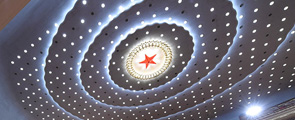Shadow puppetry, one of the oldest performing arts in the world, appeared in China long before the invention of motion pictures and television. It has been a popular form of entertainment in China for centuries. Shadow puppetry is a combination of performing arts and the art of carving. Shadow puppets are not only essential elements of stagecraft but also lovely handcrafted objects of art in their own right.

Shadow puppetry
“Chinese shadow puppetry had much to do with religion. Its birth, development, and spread were closely related to religious culture. Religious art was a major influence on the shapes and manufacture of shadow puppets. It was Buddhism that helped shadow puppetry spread in China,” said Sun Jianjun, associate professor of School of Fine Arts of Tsinghua University.
The puppets are made of ox, sheep, or donkey skin. Preparing a hide that will be used to make a shadow puppet requires special tanning and processing techniques. First, the raw pelt is soaked in clear water or limewater. Then it is stretched tightly across a wooden frame and left to dry until it is flat and even. The hair and remaining flesh are scrapped off, leaving a thin, translucent skin that makes an ideal raw material for creating a shadow puppet.
After the puppets have been carved, they are dyed in bright colors to enhance the puppets' appearance and make them more eye-catching. The method of dying is derived from Chinese New Year's pictures. The principal colors used are red, green, black, and yellow.
“Chinese shadow puppetry shows a strong Chinese opera influence. The shadow puppeteers' property trunks contain most objects found in everyday life. These include clothes, ornaments, towers, pavilions, furnishings, and scenery. Many of these are based on items existed in the past,” said Sun Jianjun.
Shadow plays are a two-dimensional form because the puppets, scenery, and other props are all flat. Most of the faces of the shadow figures are depicted in profile. Figures with faces represented in profile are more expressive and can be better animated and manipulated.
The faces of the shadow figures – representing as they do human, supernatural, and animal beings – pose an intricate and interesting problem. Their facial features are often exaggerated. The young male and female roles, for example, usually have an elegant, noble slant of forehead and nose. Ruffians and treacherous characters always have exaggeratedly large eyes and bushy eyebrows.
“We should preserve the tradition of our shadow puppetry. We should preserve not only the puppets and props but also the theater texts and music. They are part of Chinese culture. They may help promote Chinese culture and contribute to the creation of new art forms,” said Sun Jianjun.
Shadow theater is a popular form of drama in China. It has entertained the Chinese for centuries, bringing joy to them and raising their hopes.






 Newsletter
Newsletter
 CCTV Live
CCTV Live Video
Video Programs
Programs Schedule
Schedule





































